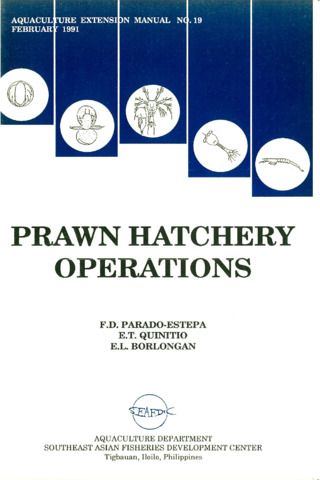Economic analysis of prawn (Penaeus monodon) culture in the Philippines, II: Grow-out operations
| dc.contributor.author | Hatch, U. | |
| dc.contributor.author | Agbayani, Renato F. | |
| dc.contributor.author | Belleza, E. | |
| dc.date.accessioned | 2013-04-10T02:48:23Z | |
| dc.date.available | 2013-04-10T02:48:23Z | |
| dc.date.issued | 1996 | |
| dc.identifier.citation | Hatch, U., Agbayani, R., & Belleza, E. (1996). Economic analysis of prawn (Penaeus monodon) culture in the Philippines, II: Grow-out operations. Asian Fisheries Science, 9(2), 127–141. | en |
| dc.identifier.issn | 0116-6514 | |
| dc.identifier.uri | http://hdl.handle.net/10862/1560 | |
| dc.description.abstract | The dramatic fall in prawn (Penaeus monodon) prices coupled with environmental concerns has resulted in a relative stagnation of prawn grow-out operations in the Philippines. Leaders of the Philippine aquaculture sector are concerned that their cost of production is higher than that of their close competitors in Indonesia and Thailand. Also, the environmental and production crash experienced in Taiwan has led to a general perception that intensive culture cannot be sustained. The sector recently experienced a lack of direction and growth, combined with crowded water sheds, excessive use of water bodies, overuse of groundwater and continued destruction of mangrove. A field survey of prawn growers was conducted in August-October 1992 using a standardized economic questionnaire that included costs, returns and growers perceptions of constraints. Economic estimates were developed for representative production systems; intensive, semi-intensive, extensive and prawn-milkfish rotation. The incentive to expand the prawn pond area is not strong. Existing intensive facilities can be operated efficiently and profitably, but new intensive operations will most likely need to include water treatment capabilities for water entering and exiting grow-out ponds. Canals, reservoirs or ponds used for water quality improvement may be able to concurrently produce a profitable crop, such as milkfish-prawn rotation. Internal rate of return for semi-intensive ponds using earthen ponds was higher than for other culture systems. If, over time, water quality and conservation constraints are sufficiently addressed, stocking densities might be increased. Research and extension programs targeting equity should focus on integrated systems. | en |
| dc.language.iso | en | en |
| dc.publisher | Asian Fisheries Society | en |
| dc.subject | Penaeus monodon | en |
| dc.subject | Philippines | en |
| dc.title | Economic analysis of prawn (Penaeus monodon) culture in the Philippines, II: Grow-out operations | en |
| dc.type | Article | en |
| dc.citation.volume | 9 | |
| dc.citation.issue | 2 | |
| dc.citation.spage | 127 | |
| dc.citation.epage | 141 | |
| dc.citation.journalTitle | Asian Fisheries Science | en |
| seafdecaqd.library.callnumber | VF SJ 0515 | |
| seafdecaqd.databank.controlnumber | 1996-20 | |
| dc.subject.asfa | aquaculture development | en |
| dc.subject.asfa | aquaculture economics | en |
| dc.subject.asfa | intensive aquaculture | en |
| dc.subject.asfa | pond culture | en |
| dc.subject.asfa | shrimp culture | en |
| dc.subject.scientificName | Penaeus monodon | en |
このアイテムのファイル
| ファイル | サイズ | フォーマット | 閲覧 |
|---|---|---|---|
|
このアイテムに関連するファイルは存在しません。 |
|||
このアイテムは次のコレクションに所属しています
-
Journal Articles [1258]
These papers were contributed by Department staff to various national and international journals.




